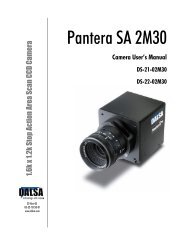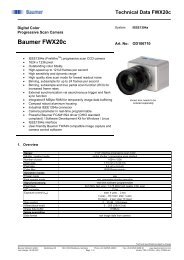Spyder 3 Camera User's Manual GigE Dual Line - Frame Grabbers
Spyder 3 Camera User's Manual GigE Dual Line - Frame Grabbers
Spyder 3 Camera User's Manual GigE Dual Line - Frame Grabbers
Create successful ePaper yourself
Turn your PDF publications into a flip-book with our unique Google optimized e-Paper software.
70<br />
<strong>Spyder</strong> 3 <strong>GigE</strong> User <strong>Manual</strong><br />
Calibrating the <strong>Camera</strong> to Remove Non-Uniformity (Flat<br />
Field Correction)<br />
Flat Field Correction Overview<br />
Note: The QuickCam software that ships with the <strong>Spyder</strong> 3 <strong>GigE</strong> camera has a flat field correction<br />
wizard. For easy flat field correction, use the wizard located on the Calibration tab.<br />
This camera has the ability to calculate correction coefficients in order to remove nonuniformity<br />
in the image. This video correction operates on a pixel-by-pixel basis and<br />
implements a two point correction for each pixel. This correction can reduce or eliminate<br />
image distortion caused by the following factors:<br />
• Fixed Pattern Noise (FPN)<br />
• Photo Response Non Uniformity (PRNU)<br />
• Lens and light source non-uniformity<br />
Correction is implemented such that for each pixel:<br />
V output =[(V input - FPN( pixel ) - digital offset) * PRNU(pixel) – Background Subtract] x System Gain<br />
where V output = digital output pixel value<br />
V input = digital input pixel value from the CCD<br />
PRNU( pixel) = PRNU correction coefficient for this pixel<br />
FPN( pixel ) = FPN correction coefficient for this pixel<br />
Background Subtract = background subtract value<br />
System Gain = digital gain value<br />
The algorithm is performed in two steps. The fixed offset (FPN) is determined first by<br />
performing a calibration without any light. This calibration determines exactly how much<br />
offset to subtract per pixel in order to obtain flat output when the CCD is not exposed.<br />
The white light calibration is performed next to determine the multiplication factors<br />
required to bring each pixel to the required value (target) for flat, white output. Video<br />
output is set slightly above the brightest pixel (depending on offset subtracted).<br />
Flat Field Correction Restrictions<br />
Note: If your<br />
illumination or white<br />
reference does not<br />
extend the full field of<br />
view of the camera,<br />
the camera will send a<br />
warning.<br />
It is important to do the FPN correction first. Results of the FPN correction are used in the<br />
PRNU procedure. We recommend that you repeat the correction when a temperature<br />
change greater than 10°C occurs or if you change the analog gain, integration time, or line<br />
rate.<br />
PRNU correction requires a clean, white reference. The quality of this reference is<br />
important for proper calibration. White paper is often not sufficient because the grain in<br />
the white paper will distort the correction. White plastic or white ceramic will lead to<br />
better balancing.<br />
03-032-10158-06 DALSA
















